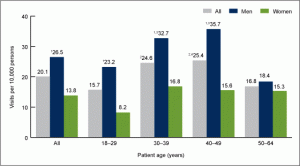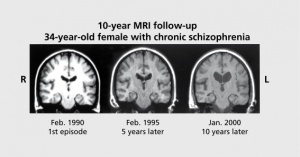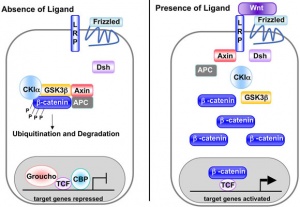Schizophrenia
Schizophrenia is a chronic disorder affecting how a person thinks, feels, and behaves. Around 1% of the United States population is diagnosed with schizophrenia. Now, 1% may not seem like a lot, however, it is about 3.3 million people. 3.3 million people just like you suffer from delusions, hallucinations, disorganized speech, mood disturbances, disorganized motor behaviors, and

disturbances of volition. At that is just in the U.S.! It is estimated by the World Health Organization that 20 million people worldwide are diagnosed with schizophrenia.
During 2009-2011, an estimated 382,000 ER visits in the US related to schizophrenia. Of those visits 32.7% had to be admitted to the hospital. Schizophrenia diagnoses occupy 20-40% of psychiatric hospital beds. Figure 1, shows the age ranges of these patients and the differences in gender.

Individuals with schizophrenia have a set of positive and negative symptoms. Positive symptoms are distortions of a person’s thinking. Negative symptoms make feeling and expressing emotions for the person a challenge. In figure 2, the distinction between positive and negative symptoms is depicted.
It is incredibly important for research on schizophrenia to continue. As of now the cause of schizophrenia is still quite wonky.
Changes in the brain
Through brain imaging, researchers have found that schizophrenia in the brain can look like: a reduction of gray and white-matter, temporal lobe volume reductions, anomalies of the superior temporal gyrus, enlargement of the

ventricles, and reduced connection between temporal and frontal lobe white matter. In figure 3, you can see the changes in the brain of 34-year-old female patient with schizophrenia. These images clearly show a reduction in white matter and enlargement of the ventricles over the course of several years.
An emerging view is that schizophrenia is a developmental disease caused by changes in the structure and functioning of important brain systems involved in working memory, declarative memory, language processing, etc. These changes appear to be influenced by genetic and environmental risk factors present during development prenatal, childhood, and adolescence.
Molecular changes in the brain
There is evidence accumulating on the Wnt signaling pathway and its role in schizophrenia. This pathway may lead to answers on how to best treat symptoms of schizophrenia and possible causes of these symptoms.

Schizophrenics have an overactive dopamine system in their brain. When dopamine binds to its D2 receptors it inhibits the enzyme known as Akt, which decreases inhibitory phosphorylation of GSK3-beta. In a pathway known as Wnt, if GSK3-beta cannot be inhibited it will remain in a “destruction complex”, that is responsible for breaking down beta-catenin. Beta-catenin is the molecule that binds to a set of transcription factors to tell them to start transcribing a certain gene. If the destruction complex destroys beta-catenin, then we cannot express genes that are important for neural development and neural system functioning. Figure 4, represents the wnt signaling pathway. On the left, there is no Wnt signal attached to the receptor, leading to the degradation of beta-catenin. On the right, there is a Wnt signal on the receptor, so beta-catenin can initiate gene transcription.
This is what we see in schizophrenia. The brain is not reading important genes, so abnormal development and functioning occurs, which can lead to the disease state of schizophrenia.
Substance Abuse Disorder
47% of patients with schizophrenia have serious problems with drug or alcohol abuse during their lifetime. The following are estimated percentages of drug abuse for people diagnosed with schizophrenia:
- 60-90% cigarette smoking
- 21-86% alcohol
- 17-83% cannabis
- 15-50% cocaine
The common theory behind why those with schizophrenia have substance abuse disorders is it helps lessen pain, symptoms of the disease, and adverse side effects of medications. A biologically based theory is that schizophrenia and substance use disorders may share a common pathophysiology in overlapping neural circuits, thus may relate to dysfunction of the brain reward circuit in patients.
Final word
I bring up the prevalence of substance abuse disorder with schizophrenia to push empathy on to you for those with schizophrenia. These patients have chemical and structural changes occurring inside their brain. They have no control over this. Something occured in their development, at what point we don’t know, but something happened that caused this disease. A disease that is so painful, many turn to self-medication with drugs to survive. The stereotype of people with schizophrenia is that they are crazy. But, these people are people. Life for them is not like it is for us, but it is not their fault. So, the best thing for us to do is to show the empathy. We can never understand what it’s like to have a brain like theirs, but we can give kindness, compassion, and empathy.
Resources:
https://www.ncbi.nlm.nih.gov/pmc/articles/PMC3800495/